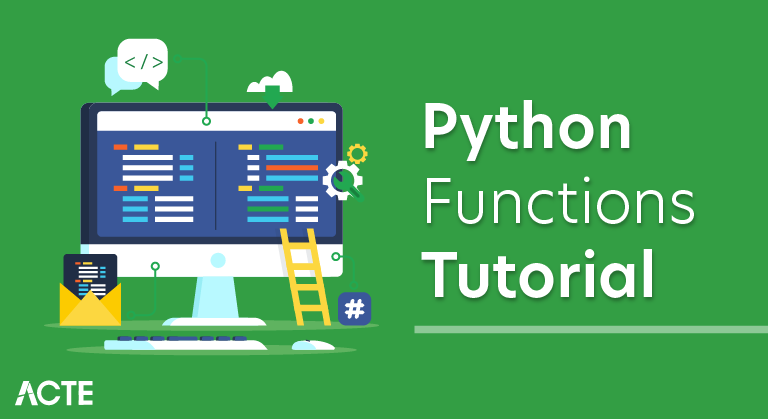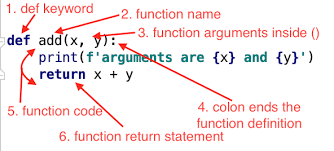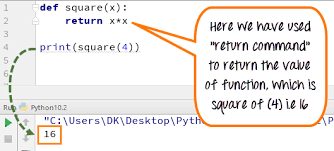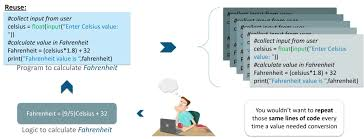
Python – Functions
A function is a block of organized, reusable code that is used to perform a single, related action. Functions provide better modularity for your application and a high degree of code reusing.

As you already know, Python gives you many built-in functions like print(), etc. but you can also create your own functions. These functions are called user-defined functions.
Defining a Function:
You can define functions to provide the required functionality. Here are simple rules to define a function in Python.
- Function blocks begin with the keyword def followed by the function name and parentheses ( ( ) ).
- Any input parameters or arguments should be placed within these parentheses. You can also define parameters inside these parentheses.
- The first statement of a function can be an optional statement – the documentation string of the function or docstring.
- The code block within every function starts with a colon (:) and is indented.
- The statement return [expression] exits a function, optionally passing back an expression to the caller. A return statement with no arguments is the same as return None
Syntax
- def functionname( parameters ):
- “function_docstring”
- function_suite
- return [expression]
By default, parameters have a positional behavior and you need to inform them in the same order that they were defined.

Example
The following function takes a string as input parameter and prints it on standard screen.
def printme( str ): “This prints a passed string into this function” print str return Calling a Function Defining a function only gives it a name, specifies the parameters that are to be included in the function and structures the blocks of code. Once the basic structure of a function is finalized, you can execute it by calling it from another function or directly from the Python prompt Following is the example to call printme() function:- #!/usr/bin/python
- # Function definition is here def printme( str ):
- “This prints a passed string into this function” print str return;
- # Now you can call printme function printme(“I’m first call to user defined function!”)
- printme(“Again second call to the same function”)
When the above code is executed, it produces the following result
I’m the first call to a user defined function!
Again second call to the same function
Pass by reference vs value:
All parameters (arguments) in the Python language are passed by reference. It means if you change what a parameter refers to within a function, the change also reflects back in the calling function. For example:
- #!/usr/bin/python
- # Function definition is here
- def changeme( mylist ):
- “This changes a passed list into this function”
- mylist.append([1,2,3,4]);
- print “Values inside the function: “, mylist
- return
- # Now you can call changeme function
- mylist = [10,20,30];
- changeme( mylist );
- print “Values outside the function: “, mylist
Here, we are maintaining reference of the passed object and appending values in the same object. So, this would produce the following result
- Values inside the function: [10, 20, 30, [1, 2, 3, 4]]
- Values outside the function: [10, 20, 30, [1, 2, 3, 4]]
There is one more example where argument is being passed by reference and the reference is being overwritten inside the called function.
- #!/usr/bin/python
- # Function definition is here
- def changeme( mylist ):
- “This changes a passed list into this function”
- mylist = [1,2,3,4]; # This would assig new reference in mylist
- print “Values inside the function: “, mylist
- return
- # Now you can call changeme function
- mylist = [10,20,30];
- changeme( mylist );
- print “Values outside the function: “, mylist
The parameter mylist is local to the function changeme. Changing mylist within the function does not affect mylist. The function accomplishes nothing and finally this would produce the following result −
- Values inside the function: [1, 2, 3, 4]
- Values outside the function: [10, 20, 30]
Function Arguments:
You can call a function by using the following types of formal arguments −
- Required arguments
- Keyword arguments
- Default arguments
- Variable-length arguments
Required arguments:
Required arguments are the arguments passed to a function in correct positional order. Here, the number of arguments in the function call should match exactly with the function definition.
To call the function printme(), you definitely need to pass one argument, otherwise it gives a syntax error as follows:
- #!/usr/bin/python
- # Function definition is here
- def printme( str ):
- “This prints a passed string into this function”
- print str
- return;
- # Now you can call printme function
- printme()
When the above code is executed, it produces the following result −
- Traceback (most recent call last):
- File “test.py”, line 11, in <module>
- printme();
- TypeError: printme() takes exactly 1 argument (0 given)
Keyword arguments:
Keyword arguments are related to the function calls. When you use keyword arguments in a function call, the caller identifies the arguments by the parameter name.
This allows you to skip arguments or place them out of order because the Python interpreter is able to use the keywords provided to match the values with parameters. You can also make keyword calls to the printme() function in the following ways:
- #!/usr/bin/python
- # Function definition is here
- def printme( str ):
- “This prints a passed string into this function”
- print str
- return;
- # Now you can call printme function
- printme( str = “My string”)
The following example gives a more clear picture. Note that the order of parameters does not matter.
- #!/usr/bin/python
- # Function definition is here
- def printinfo( name, age ):
- “This prints a passed info into this function”
- print “Name: “, name
- print “Age “, age
- return;
- # Now you can call printinfo function
- printinfo( age=50, name=”miki” )
Default arguments:
A default argument is an argument that assumes a default value if a value is not provided in the function call for that argument. The following example gives an idea on default arguments, it prints default age if it is not passed.
- #!/usr/bin/python
- # Function definition is here def printinfo( name, age = 35 ):
- “This prints a passed info into this function” print “Name: “,
- name print “Age “, age return;
- # Now you can call printinfo function printinfo( age=50, name=”miki” )
- printinfo( name=”miki” )
- When the above code is executed, it produces the following result − Name: miki Age 50
- Name: miki Age 35
Variable-length arguments:

You may need to process a function for more arguments than you specified while defining the function. These arguments are called variable-length arguments and are not named in the function definition, unlike required and default arguments.
Syntax for a function with non-keyword variable arguments is this:
- def functionname([formal_args,] *var_args_tuple ):
- “function_docstring”
- function_suite
- return [expression]
An asterisk (*) is placed before the variable name that holds the values of all non keyword variable arguments. This tuple remains empty if no additional arguments are specified during the function call. Following is a simple example:
- def functionname([formal_args,] *var_args_tuple ):
- “function_docstring”
- function_suite
- return [expression]
An asterisk (*) is placed before the variable name that holds the values of all non keyword variable arguments. This tuple remains empty if no additional arguments are specified during the function call. Following is a simple example:
- #!/usr/bin/python
- # Function definition is here
- def printinfo( arg1, *vartuple ):
- “This prints a variable passed arguments”
- print “Output is: “
- print arg1
- for var in var tuple:
- print var
- return;
- # Now you can call printinfo function
- printinfo( 10 )
- printinfo( 70, 60, 50 )
When the above code is executed, it produces the following result −
- Output is:
- 10
- Output is:
- 70
- 60
- 50
The Anonymous Functions:These functions are called anonymous because they are not declared in the standard manner by using the def keyword. You can use the lambda keyword to create small anonymous functions.
- Lambda forms can take any number of arguments but return just one value in the form of an expression. They cannot contain commands or multiple expressions.
- An anonymous function cannot be a direct call to print because lambda requires an expression
- Lambda functions have their own local namespace and cannot access variables other than those in their parameter list and those in the global namespace.
- Although it appears that lambda’s are a one-line version of a function, they are not equivalent to inline statements in C or C++, whose purpose is by passing function stack allocation during invocation for performance reasons.
Syntax
The syntax of lambda functions contains only a single statement, which is as follows
lambda [arg1 [,arg2,…..argn]]:expression
Following is the example to show how lambda form of function works −
- #!/usr/bin/python
- # Function definition is here
- sum = lambda arg1, arg2: arg1 + arg2;
- # Now you can call sum as a function
- print “Value of total : “, sum( 10, 20 )
- print “Value of total : “, sum( 20, 20 )
- When the above code is executed, it produces the following result −
- Value of total : 30
- Value of total : 40
The return Statement:
- The statement return [expression] exits a function, optionally passing back an expression to the caller. A return statement with no arguments is the same as return None.
- All the above examples are not returning any value. You can return a value from a function as follows:
- #!/usr/bin/python
- # Function definition is here
- def sum( arg1, arg2 ):
- # Add both the parameters and return them.”
- total = arg1 + arg2
- print “Inside the function : “, total
- return total;
- # Now you can call sum function
- total = sum( 10, 20 );
- print “Outside the function : “, total
When the above code is executed, it produces the following result −
- Inside the function : 30
- Outside the function : 30
Scope of Variables:
All variables in a program may not be accessible at all locations in that program. This depends on where you have declared a variable.
The scope of a variable determines the portion of the program where you can access a particular identifier. There are two basic scopes of variables in Python −
- Global variables
- Local variables
Global vs. Local variables:
- Variables that are defined inside a function body have a local scope, and those defined outside have a global scope.
- This means that local variables can be accessed only inside the function in which they are declared, whereas global variables can be accessed throughout the program body by all functions. When you call a function, the variables declared inside it are brought into scope. Following is a simple example :
- #!/usr/bin/python
- total = 0; # This is a global variable.
- # Function definition is here
- def sum( arg1, arg2 ):
- # Add both the parameters and return them.”
- total = arg1 + arg2; # Here total is the local variable.
- print “Inside the function local total : “, total
- return total;
- # Now you can call sum function
- sum( 10, 20 );
- print “Outside the function global total : “, total
When the above code is executed, it produces the following result −
- Inside the function local total : 30
- Outside the function global total : 0
Python – Modules:
- A module allows you to logically organize your Python code. Grouping related code into a module makes the code easier to understand and use. A module is a Python object with arbitrarily named attributes that you can bind and reference.
- Simply, a module is a file consisting of Python code. A module can define functions, classes and variables. A module can also include runnable code.
Example
The Python code for a module named aname normally resides in a file named aname.py. Here’s an example of a simple module, support.py
- def print_func( par ):
- print “Hello : “, par
- return
The import Statement:
- You can use any Python source file as a module by executing an import statement in some other Python source file. The import has the following syntax −
- import module1[, module2[,… moduleN]
- When the interpreter encounters an import statement, it imports the module if the module is present in the search path. A search path is a list of directories that the interpreter searches before importing a module. For example, to import the module support.py, you need to put the following command at the top of the script −
- #!/usr/bin/python
- # Import module support
- import support
- # Now you can call defined function that module as follows
- support.print_func(“Zara”)
When the above code is executed, it produces the following result −
Hello : Zara
A module is loaded only once, regardless of the number of times it is imported. This prevents the module execution from happening over and over again if multiple imports occur.
The from…import Statement:
Python from statement lets you import specific attributes from a module into the current namespace. The from…import has the following syntax −
- from modname import name1[, name2[, … nameN]]
For example, to import the function fibonacci from the module fib, use the following statement −
- from fib import fibonacci
This statement does not import the entire module fib into the current namespace; it just introduces the item fibonacci from the module fib into the global symbol table of the importing module.
The from…import * Statement:
- It is also possible to import all names from a module into the current namespace by using the following import statement −
- from modname import *
- This provides an easy way to import all the items from a module into the current namespace; however, this statement should be used sparingly.
Locating Modules:
When you import a module, the Python interpreter searches for the module in the following sequences :
- The current directory.
- If the module isn’t found, Python then searches each directory in the shell variable PYTHONPATH.
- If all else fails, Python checks the default path. On UNIX, this default path is normally /usr/local/lib/python/.
The module search path is stored in the system module as the sys.path variable. The sys.path variable contains the current directory, PYTHONPATH, and the installation-dependent default.
The PYTHONPATH Variable:
The PYTHONPATH is an environment variable, consisting of a list of directories. The syntax of PYTHONPATH is the same as that of the shell variable PATH.
Here is a typical PYTHONPATH from a Windows system:
- set PYTHONPATH = c:\python20\lib;
- And here is a typical PYTHONPATH from a UNIX system −set PYTHONPATH = /usr/local/lib/python
Namespaces and Scoping:
- Variables are names (identifiers) that map to objects. A namespace is a dictionary of variable names (keys) and their corresponding objects (values).
- A Python statement can access variables in a local namespace and in the global namespace. If a local and a global variable have the same name, the local variable shadows the global variable.
- Each function has its own local namespace. Class methods follow the same scoping rule as ordinary functions.
- Python makes educated guesses on whether variables are local or global. It assumes that any variable assigned a value in a function is local.
- Therefore, in order to assign a value to a global variable within a function, you must first use the global statement.
- The statement global VarName tells Python that VarName is a global variable. Python stops searching the local namespace for the variable.
- For example, we define a variable Money in the global namespace. Within the function Money, we assign Money a value, therefore Python assumes Money as a local variable. However, we assessed the value of the local variable Money before setting it, so an UnboundLocalError is the result. Uncommenting the global statement fixes the problem.
- #!/usr/bin/python
- Money = 2000
- def AddMoney():
- # Uncomment the following line to fix the code:
- # global Money
- Money = Money + 1
- print Money
- AddMoney()
- print Money
- The dir( ) Function
- The dir() built-in function returns a sorted list of strings containing the names defined by a module.
The list contains the names of all the modules, variables and functions that are defined in a module. Following is a simple example:
- #!/usr/bin/python
- # Import built-in module math
- import math
- content = dir(math)
- print content
When the above code is executed, it produces the following result −
- [‘__doc__’, ‘__file__’, ‘__name__’, ‘acos’, ‘asin’, ‘atan’,
- ‘atan2’, ‘ceil’, ‘cos’, ‘cosh’, ‘degrees’, ‘e’, ‘exp’,
- ‘fabs’, ‘floor’, ‘fmod’, ‘frexp’, ‘hypot’, ‘ldexp’, ‘log’,
- ‘log10’, ‘modf’, ‘pi’, ‘pow’, ‘radians’, ‘sin’, ‘sinh’,
- ‘sqrt’, ‘tan’, ‘tanh’]
Here, the special string variable __name__ is the module’s name, and __file__ is the filename from which the module was loaded.
The globals() and locals() Functions:
- The globals() and locals() functions can be used to return the names in the global and local namespaces depending on the location from where they are called.
- If locals() is called from within a function, it will return all the names that can be accessed locally from that function.
- If globals() is called from within a function, it will return all the names that can be accessed globally from that function.
- The return type of both these functions is a dictionary. Therefore, names can be extracted using the keys() function.
The reload() Function:
- When the module is imported into a script, the code in the top-level portion of a module is executed only once.
- Therefore, if you want to re execute the top-level code in a module, you can use the reload() function. The reload() function imports a previously imported module again. The syntax of the reload() function is this :
- reload(module_name)
- Here, module_name is the name of the module you want to reload and not the string containing the module name. For example, to reload hello module, do the following −
- reload(hello)
Packages in Python:
- A package is a hierarchical file directory structure that defines a single Python application environment that consists of modules and subpackages and sub-subpackages, and so on.
Consider a file Pots.py available in the Phone directory. This file has following line of source code −
- #!/usr/bin/python
- def Pots():
- print “I’m Pots Phone”
Similar way, we have another two files having different functions with the same name as above −
- Phone/Isdn.py file having function Isdn()
- Phone/G3.py file having function G3()
Now, create one more file __init__.py in Phone directory −
- Phone/__init__.py
To make all of your functions available when you’ve imported Phone, you need to put explicit import statements in __init__.py as follows −
- from Pots import Pots
- from Isdn import Isdn
- from G3 import G3
After you add these lines to __init__.py, you have all of these classes available when you import the Phone package.
- #!/usr/bin/python
- # Now import your Phone Package.
- import Phone
- Phone.Pots()
- Phone.Isdn()
- Phone.G3()
When the above code is executed, it produces the following result −
- I’m Pots Phone
- I’m 3G Phone
- I’m ISDN Phone
In the above example, we have taken examples of a single function in each file, but you can keep multiple functions in your files. You can also define different Python classes in those files and then you can create your packages out of those classes.
Python – Files I/O:
This chapter covers all the basic I/O functions available in Python. For more functions, please refer to standard Python documentation.
Printing to the Screen:
The simplest way to produce output is using the print statement where you can pass zero or more expressions separated by commas. This function converts the expressions you pass into a string and writes the result to standard output as follows −
- #!/usr/bin/python
- print “Python is really a great language,”, “isn’t it?”
- This produces the following result on your standard screen −
- Python is really a great language, isn’t it?
Reading Keyboard Input:
Python provides two built-in functions to read a line of text from standard input, which by default comes from the keyboard. These functions are −
- raw_input
- input
The raw_input Function:
The raw_input([prompt]) function reads one line from standard input and returns it as a string (removing the trailing newline).
- #!/usr/bin/python
- str = raw_input(“Enter your input: “)
- print “Received input is : “, str
This prompts you to enter any string and it would display the same string on the screen. When I typed “Hello Python!”, its output is like this −
- Enter your input: Hello Python
- Received input is : Hello Python
The input Function:
The input([prompt]) function is equivalent to raw_input, except that it assumes the input is a valid Python expression and returns the evaluated result to you.
- #!/usr/bin/python
- str = input(“Enter your input: “)
- print “Received input is : “, str
This would produce the following result against the entered input :
- Enter your input: [x*5 for x in range(2,10,2)]
- Received input is : [10, 20, 30, 40]
Opening and Closing Files:
- Until now, you have been reading and writing to the standard input and output. Now, we will see how to use actual data files.
- Python provides basic functions and methods necessary to manipulate files by default. You can do most of the file manipulation using a file object.
The open Function:
Before you can read or write a file, you have to open it using Python’s built-in open() function. This function creates a file object, which would be utilized to call other support methods associated with it.
Syntax
- file object = open(file_name [, access_mode][, buffering])
Here are parameter details −
- file_name − The file_name argument is a string value that contains the name of the file that you want to access.
- access_mode − The access_mode determines the mode in which the file has to be opened, i.e., read, write, append, etc. A complete list of possible values is given below in the table. This is an optional parameter and the default file access mode is read (r).
- buffering − If the buffering value is set to 0, no buffering takes place. If the buffering value is 1, line buffering is performed while accessing a file.
Conclusion:
Understanding the syntax of Python is great and all, and Python by itself is indeed a great language, but the fundamentals of Python aren’t why Python is a successful language. There are plenty of fun-to-write languages that are just like Python, such as Ruby, Julia, even R.






